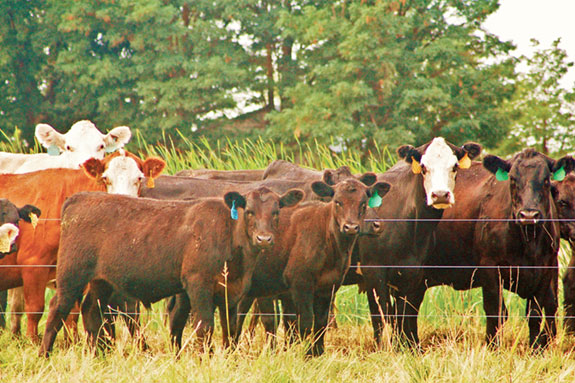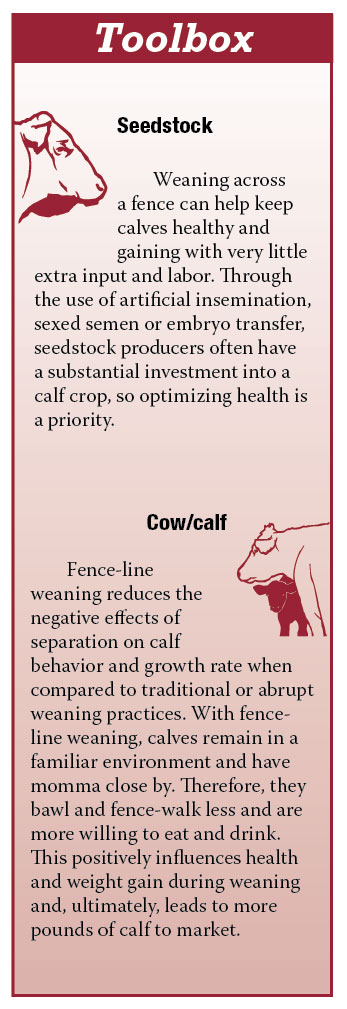The result is a less-stressed calf that bawls and fence-walks less as opposed to calves that are abruptly weaned. Research also proves that fence-line-weaned calves continue a close-to-normal growth rate and weight gain.
While this practice is relatively simple, it does require some space and a sturdy separation fence. The fence-line weaning process goes like this: Cows and calves are maintained together for several days in a pasture with ample feed resources. Calves are held here with dams so they can acclimate, and find feed and water before separation occurs.
Once separated the calves stay put, while the cows are moved to an adjoining pasture or trap. Ideally the pairs are kept separate until the bawl subsides, typically about five days, by a high-tensile electric wire or woven-wire fence with an electric wire.
One of the keys to this practice is calves remain in a familiar environment with the same feeding routine, grass and water. They still have visual contact with their dams, so the only change they undergo is no longer being able to nurse. Minimizing change – and stress – for calves is a big plus to post-weaning health.

Changing the stress level of weaning
Health is the top reason why Shaw Cattle Co. of Caldwell, Idaho, has weaned all calves on green grass, and as many as possible through a fence-line-weaning system, for over the past 20 years.
This family-run Angus, Hereford, and Red Angus seedstock operation includes Greg and Cleo Shaw, sons Tucker and Sam and their families. They annually market some 325 head of registered bulls and a top cut of replacement heifers through their winter production sale.
Greg says that the health of their calves was why they started weaning only on green grass and through a fence line at every opportunity.
“We’ll wean 400 to 500 head of calves and not doctor but one or two calves. Before in a drylot, we would always have an outbreak of sick calves at about seven to 10 days after we weaned. You could easily doctor 5 to 10 percent of them.”
He believes. “Fence-line weaning definitely changes the stress level of weaning. From a health standpoint, there is a very big benefit.”
Sam points out that from 85 to 90 percent of the Shaw calf crop is the result of either artificial insemination or embryo transfer. They have a lot invested, so setting calves back performance-wise isn’t an option for them.
John Verbance, manager of Acord Charolais Ranch, New Plymouth, Idaho, is also a believer in this weaning management system. He declares that fence-line weaning is the “only way to go.” Verbance has put this system into play for five years and, like the Shaws, uses it in combination with an aggressive vaccination program.
“Weaning is a tough process any way you do it,” he says. “To make any weaning program work, I think you need to have all of your vaccination protocols in order.”
The Acord ranch raises registered Charolais and Angus, and annually markets bulls, females and embryos through a production sale. It also turns out age- and source-verified calves.
“The nice thing about fence-line weaning, especially for us where we have irrigated pasture, is it keeps the dust down,” Verbance comments.
He explains how they start irrigating the designated pastures about two weeks before the cows and calves are turned in. They always make sure the pairs are in the same pasture for several days, where the calves will stay once weaned. When they’re split, the cows are moved just across the fence.

“The calves walk the fence maybe for the first 18 hours,” Verbance reports. “But after that, they spend a lot more time eating than bawling.”
He adds, “I find more and more, the calves wean a heck of a lot easier than the cows. In about three days you’re done. The cows might go for another day or two, but the calves care less.”
Similarly, the Shaws place cows and calves together in a pasture, where the calves will remain after separation. They leave the pairs together in this pasture for three to four days, before parting. Greg says it only takes about four to five days to wean.
The Shaws believe that fence-line-weaning works efficiently largely because a calf’s environment doesn’t change. “If you move cows and calves to a strange place, and then split them, the calves tend to want to go back to where they last nursed,” Greg explains.
While this practice is fairly simple, the Shaws do recommend having in place “an awfully good fence” with which to separate. They use a tight five-wire fence with one middle electric wire to keep calves from reaching through. The electric wire also keeps calves from bunching up and pushing against the separation fence, the most important barrier in the fence-line system.
They also recommend that calves have a good water source. “Be sure the water is situated where the calves will easily find it,” Greg advises, as well as to choose your weather for weaning. While hot weather isn’t usually an issue for them, he added, “Shade for calves would for sure be nice if you weaned in hot weather.”
Verbance agreed. “It’s important to make sure they have access to lots of fresh water all the time.” Both Acord’s and Shaw’s herds water out of irrigation ditches so nothing in their calves’ environments are new at weaning.
“I think that makes a difference – nothing is strange to them,” Verbance states. “They’re going right back into something they know. A lot of times when they’re trucked, they get to a feedlot where they’ve never been before. I don’t know if we can even imagine the stress those cattle are under when they come off that truck.”
He adds, “I think there are lots of benefits to fence-line weaning.” Echoing Greg Shaw’s comments, Verbance summarized, “The biggest benefit is the health of the calves. We very rarely have to doctor anything. I think I’ve only doctored two or three calves in five years.” ![]()
Kim Holt, Progressive Cattleman contributor
PHOTOS
TOP: Breaking the cow-calf bond nose-to-nose can help keep calves calmer, while promoting long-term health benefits. Photo courtesy of Kim Holt.
BOTTOM: Health is the top reason why Shaw Cattle Co. of Caldwell, Idaho, has weaned all calves on green grass, and as many as possible through a fence-line-weaning system, for over the past 20 years. Photo courtesy of Kim Holt.
Extra Tips
Fence-line weaning offers health and performance benefits
Data compiled though the Texas Ranch to Rail program show calves that suffer post-weaning sickness have lower average daily gains, reduced feed efficiency and lower carcass quality grades.
In scientific work carried out in a 2003 University of California, Davis study, Dr. E.O. Price’s research indicated that fence-line weaning reduces the negative effects of separation on calf behavior and growth rate.
This research found that, in the post-weaning phase, fence-line-weaned calves exhibited fewer signs of distress, such as reduced appetite and resting, and higher levels of walking and vocalization, versus their traditionally weaned counterparts. Furthermore, fence-line contact with dams at weaning minimizes reductions in weight gain so calves continue a close-to-normal growth rate.
Data from a study conducted at the New Mexico State University Corona Range Livestock Research Center also shows favorable results. Calves there were fence-line-weaned for seven days in 2006 and 2007. During those times, calves gained weight, with minimal outward signs of stress.
Plan ahead to alleviate weaning stress
While it may be impossible or impractical to fence-line-wean calves in all situations, planning ahead to help alleviate weaning stress can prove beneficial.
If fence-line contact isn’t practical, move cows far enough that they cannot hear the calves bawling. Be sure to move the cows to a new location, not the calves. Wean on green grass if possible. If weaning in a drylot or corral, place feedbunks, hay or water troughs along the fence to minimize perimeter walking.
Finally, don’t add additional stresses to weaning. Castrate, dehorn or brand calves at least three weeks before weaning and preferably prior to 3 months of age.






